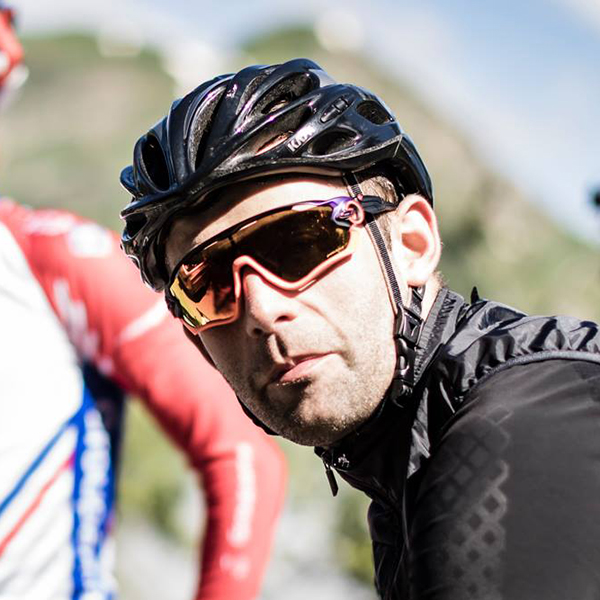The Basso Diamante is now in its eighth generation. However, in a race bike world where aero seems to trump all else, the latest Diamante’s looks are classic. I’d go so far as to call it beautiful.
The Diamante’s latest update was unveiled at Eurobike 2022, when Stan reported on its rejigged geometry, new one-piece cockpit and lighter weight, among other details.
The aim is clear: to create a race bike that excels on climbs and descents, and remains unashamedly classical in its approach to delivering overall performance, with rounded tubes and shallow profiles.
In reality? The Diamante is mostly a roaring success, excelling exactly where it’s designed to, and impressing right out of the box.
However, there’s one major design feature in the mix that should rightfully give you pause for thought.
Basso Diamante Ultegra Di2 frameset
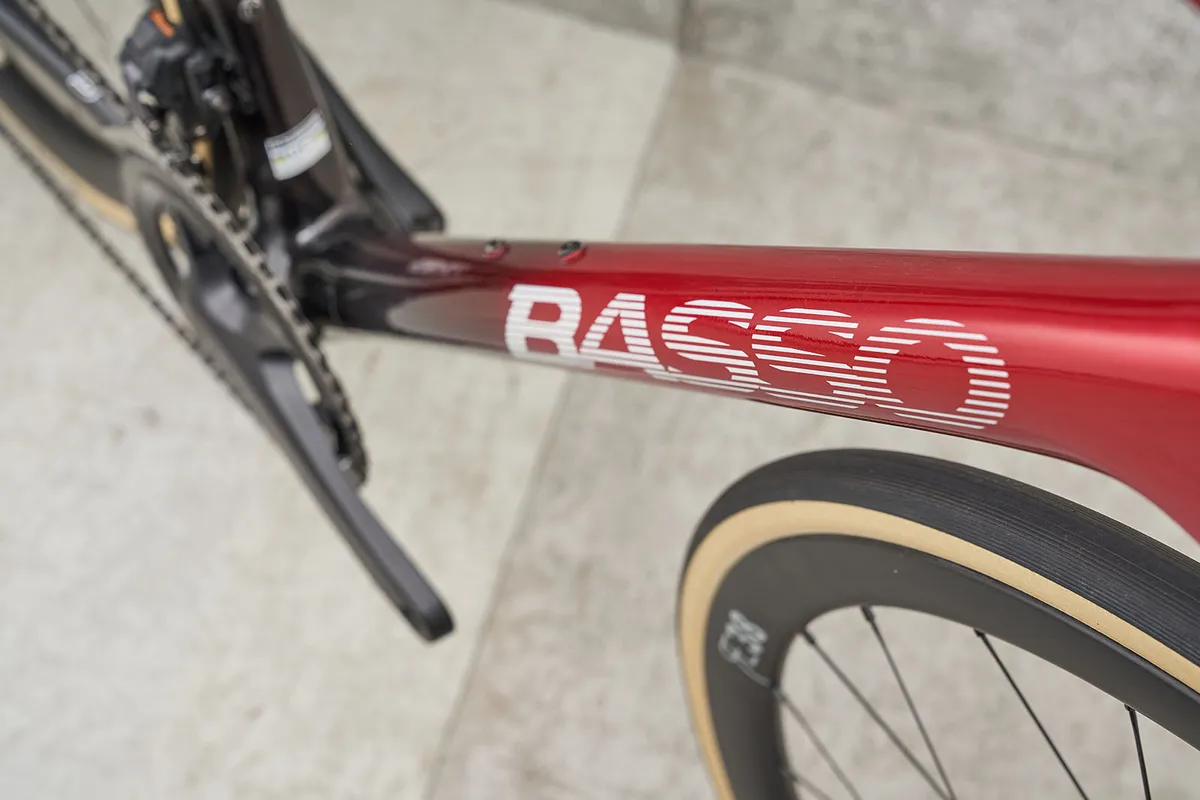
Basso says the Diamante represents “how a race bike should be” today – a bold statement given the peloton’s obsession with aerodynamics.
At a glance, there are only a few suggestions of ‘typical’ aero design in the overall aesthetic of the Diamante frameset. Tubes are rounded, profiles are shallow.
However, look closely, and there’s subtle flattening of the top tube and rear side of the seat tube, bladed fork profiles, a concave head tube and even a hint of blending from the fork shoulders to the down tube. Just a hint, though.
The new integrated aero handlebar (more on this later) means gear cable and brake hose routing is now fully internal, which should help smooth airflow to a degree.
Basso says the tube shapes better leverage the natural properties of carbon fibre and hone them to bring what Basso views as optimal race bike behaviour.
Of course, every bike brand working with carbon frames does this to a degree, but instead of oversizing areas or squaring tubes, here Basso says it has prioritised rounded tube shapes to improve stiffness and efficiency, plus minimise weight.
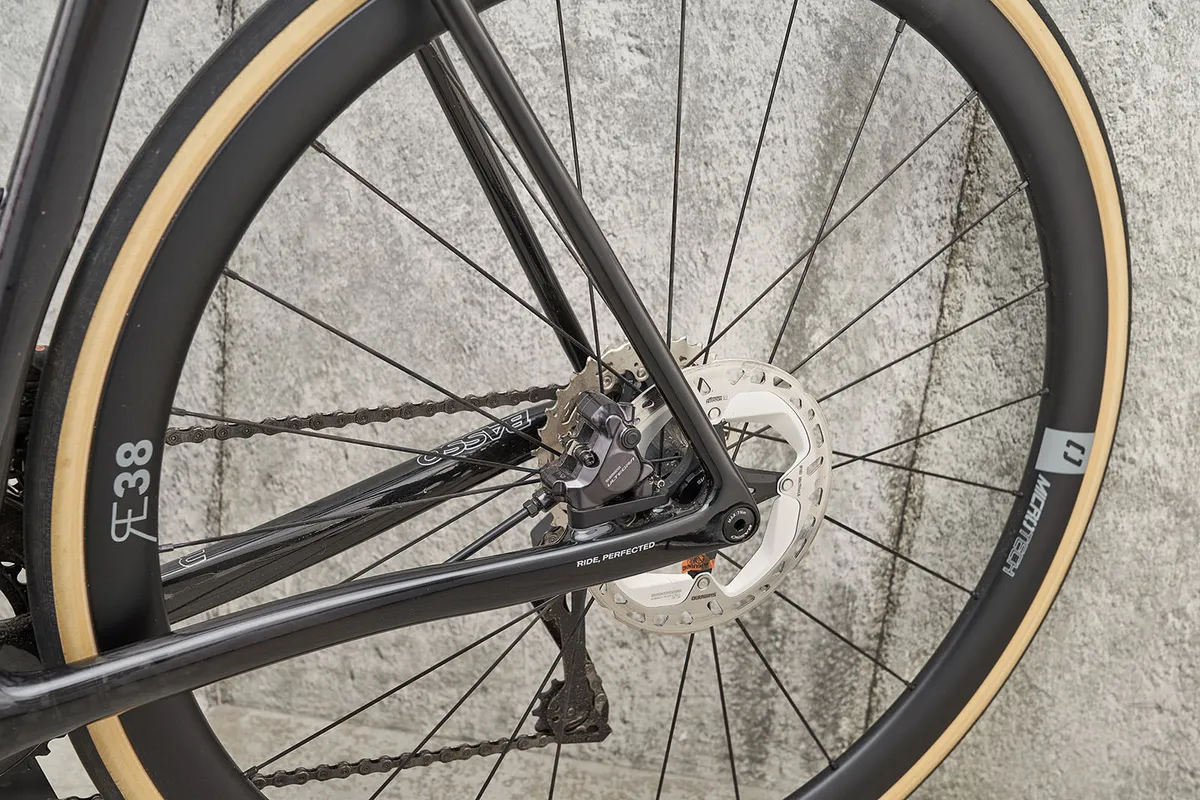
The rear chainstays have been lengthened, their junction point with the seat tube raised versus the previous generation, which Basso says “balances” the ride following its implementation of a lighter carbon layup.
A mix of Toray 40T and 30T carbon fibre makes up the frame and fork, which is claimed (in tandem with the tube shapes) to produce an optimum blend of stiffness, weight and compliance.
In a size 53, the frame is claimed to weigh 760g.
The frame and fork are capable of playing host to 32mm-wide tyres, while the bottom bracket is a press-fit BB86 model.
Basso Diamante Ultegra Di2 geometry
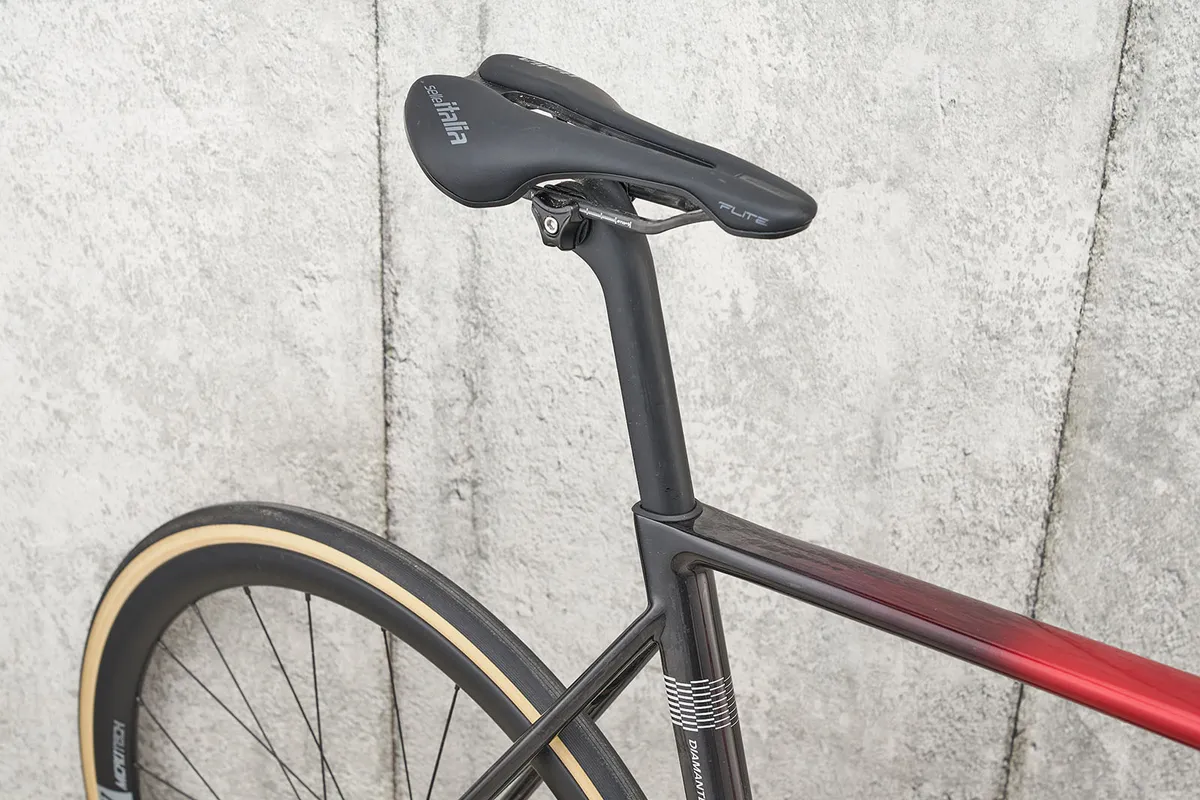
The Diamante’s geometry is in pure race bike territory.
The head tube angle is a steep 73.1 degrees on my size 58 test bike, while the 73-degree seat tube angle pitches the rider over the bottom bracket.
A 180mm head tube length contributes to the 608mm stack height. Up to 45mm of split spacers can be added under the stem to heighten this, although 15mm are provided with the bike as standard.
This might sound a departure from the norm, but the new Levita bar-stem features an 11-degree negative rise, via a downward kink in its length. Essentially, it lowers the contact point to counter the tall stack. In doing so, it also lengthens the reach to the bars.
On paper, the frame delivers 389mm reach, but add in the combination of the negative-rise, 120mm-long stem as specced on a size 58 and it feels noticeably long and low.
At the rear, compact 402mm chainstays keep power transfer taut and reactions sharp.
| | 45 | 48 | 51 | 53 | 56 | 58 | 61 |
|---|---|---|---|---|---|---|---|
| Seat angle (degrees) | 76 | 75 | 75 | 74 | 73.5 | 73 | 72.5 |
| Head angle (degrees) | 71.3 | 71.4 | 71.6 | 71.9 | 73.1 | 73.1 | 73.6 |
| Chainstay (mm) | 400 | 400 | 400 | 400 | 402 | 402 | 406 |
| Seat tube (mm) | 450 | 480 | 510 | 530 | 560 | 580 | 610 |
| Top tube (mm) | 505 | 515 | 525 | 545 | 560 | 575 | 590 |
| Head tube (mm) | 101 | 101 | 126 | 138 | 155 | 180 | 203 |
| Stack (mm) | 521.7 | 521.8 | 546.2 | 558.8 | 584.3 | 608 | 632.2 |
| Reach (mm) | 374.9 | 375.2 | 378.6 | 384.8 | 386.9 | 389 | 390.7 |
| handlebar width (mm) | 400 | 400 | 420 | 420 | 420 | 420 | 440 |
| Stem length (mm) | 90 | 90 | 100 | 100 | 110 | 120 | 120 |
Basso Diamante Ultegra Di2 specification
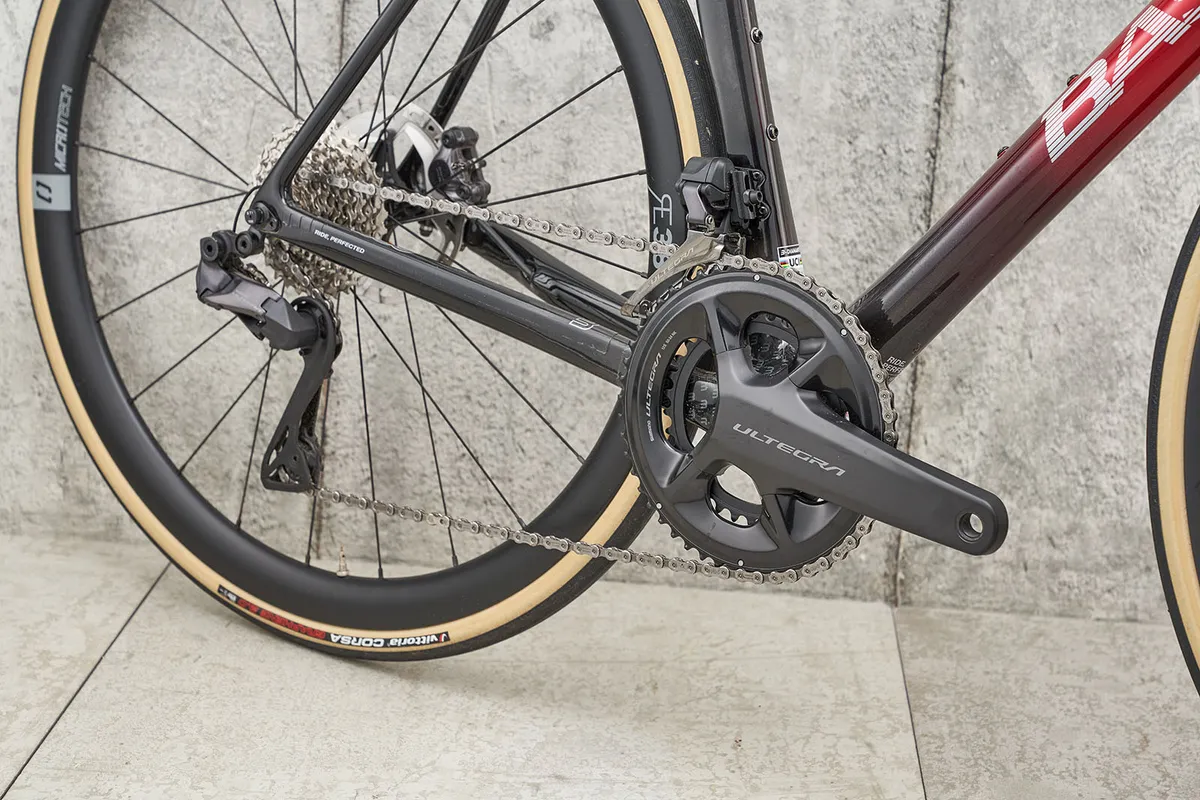
As the name suggests, this Basso Diamante is fitted with a Shimano Ultegra Di2 R8100 drivetrain.
There’s little to criticise with Ultegra Di2 – the latest generation of the second-tier groupset is BikeRadar’s current pick of Shimano’s road-going Di2 stable.
It delivers identical shifting and braking performance to the Dura-Ace R9200 Di2 flagship groupset with no meaningful drawbacks (unless a couple of hundred grams really swings spec choice for you).
The aforementioned Basso Levita integrated bar-stem is distinctive by its negative rise. It’s been designed to complement the tall stack of the bike and create that aggressive low-slung front end.
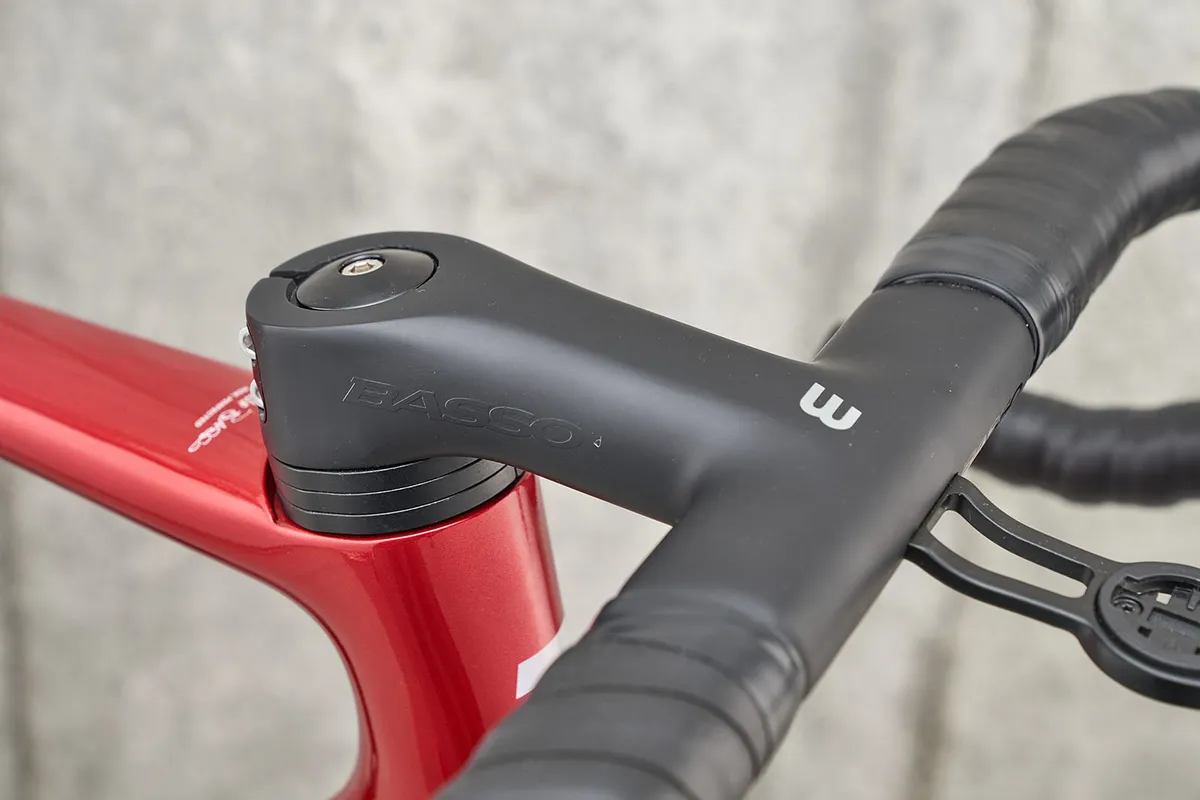
It features capacity for a neat integrated computer mount, which came fitted to my test bike.
The rear sees a 15mm-offset carbon seatpost fitted, although a zero-offset post is also available.
A Selle Italia Flite Boost Carbon SF saddle is fitted atop the seatpost. The carbon-railed model is a neat inclusion, and should help improve comfort and reduce overall weight (slightly).
More fundamental to the ride quality is the inclusion of a Microtech RE38 carbon wheelset.
Where many brands can fit wheels of varying modernity in design, the RE38 rims are right on the latest standards.
They feature a 23mm internal width, which helps to plump out the fitted Vittoria Corsa G2.0 28c clincher tyres to around 29mm, and is ideal to support even wider rubber should you so choose.
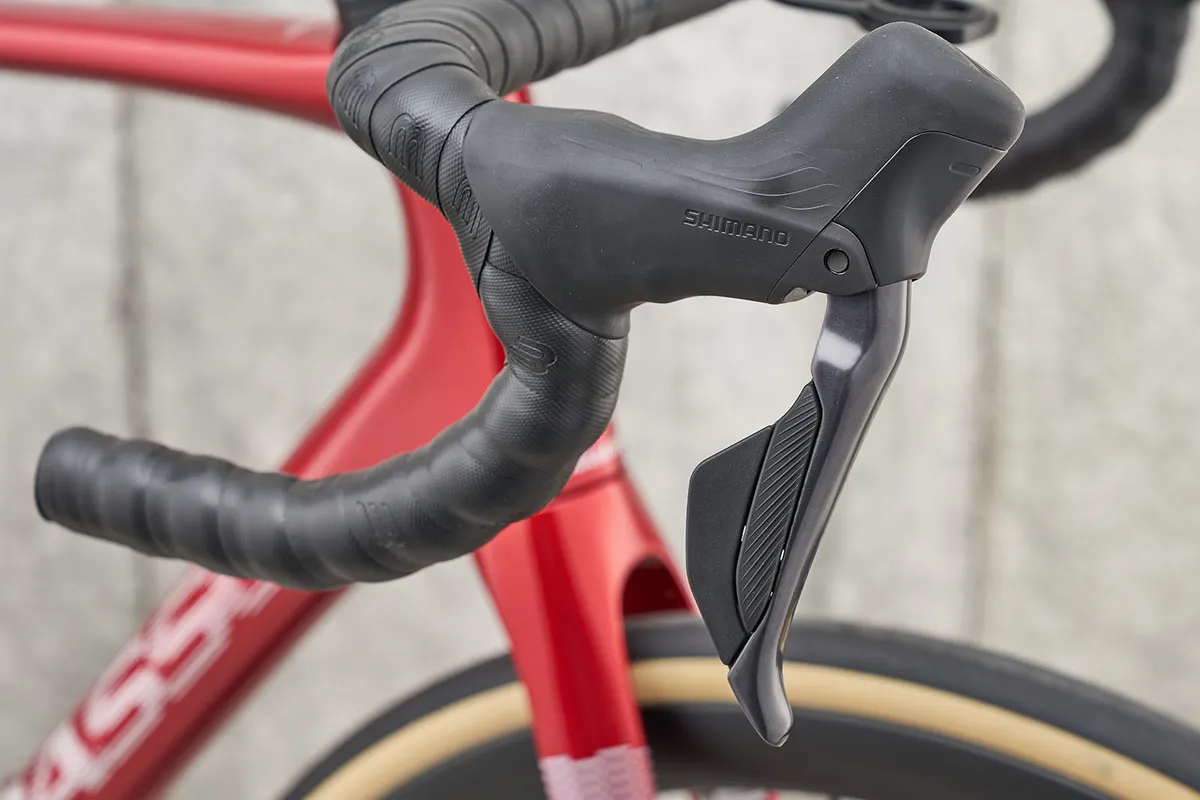
The 38mm depth isn’t going to affect aero performance too drastically, but it should offer a good mix of stability and efficiency from the get-go.
The rims are also tubeless-ready, but you’ll need to add your own tubeless tyres and valves.
Sapim bladed aero spokes lace the wheels to machined alloy hubs with steel bearings.
The Diamante in this spec will set you back £7,199. Time was that such a price tag might gain you a Dura-Ace Di2-level groupset, but with prices increasing, the goalposts have (sadly) shifted.
At the Ultegra Di2 or SRAM Force eTap AXS level, Canyon offers its Ultimate CF SL Aero for £4,799, while an Ultimate SLX with Ultegra or Force drivetrains can be had for £6,199 or £5,999 respectively.
Outside of the direct-sales model, a Specialized Tarmac SL7 Expert will set you back £7,250, and a Trek Emonda SLR 7 comes in at £7,910.
All-in, the Diamante weighs 7.58kg.
Basso Diamante Ultegra Di2 ride impressions
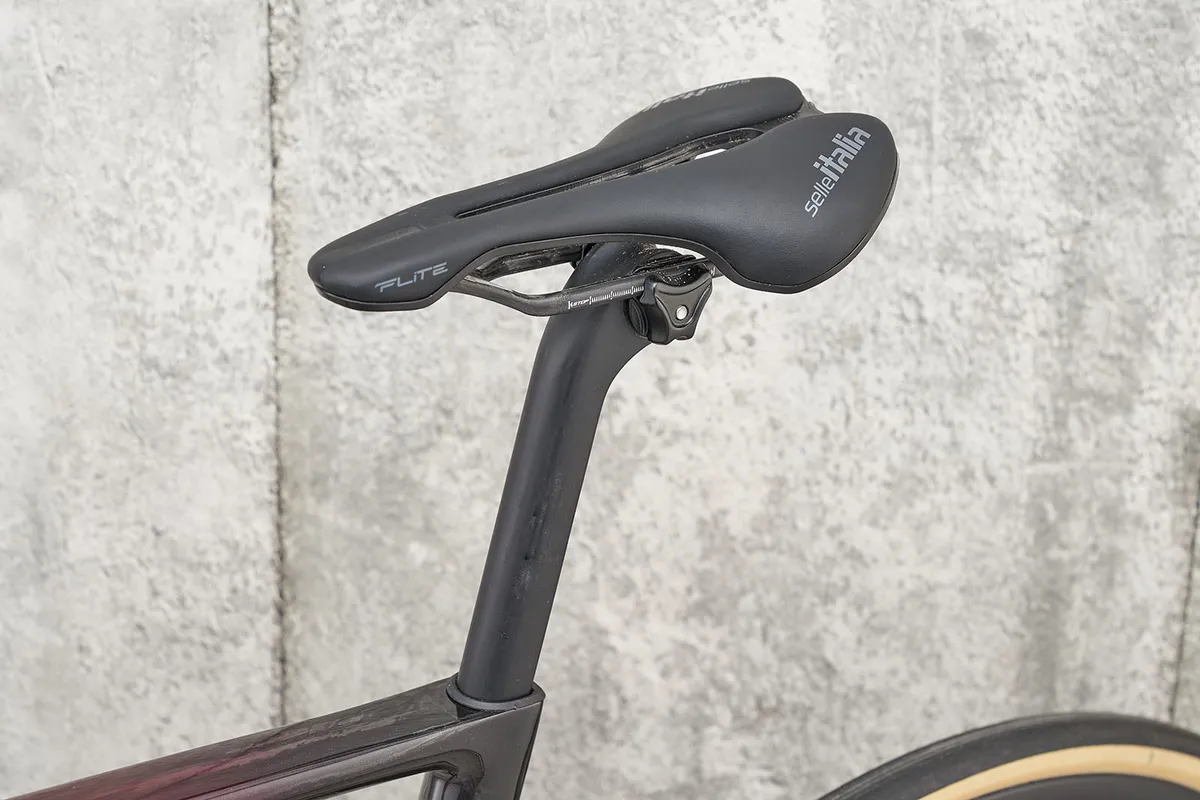
The Diamante’s real strength lies in combining tactile, involving handling with good levels of stiffness and a surprising amount of compliance.
That's surprising, because Basso doesn’t pitch comfort as one of the Diamante’s lead selling points.
While I’m convinced the premium tyre choice and wide rims help to smooth the ride over pimply tarmac, the frame’s slim, long seatstays and carbon seatpost help to further dissipate road buzz.
That said, Basso says the tall seatstays are designed primarily to balance the overall ride, compensating for the lightened frame versus the previous version.
Comfort is certainly part of that equation, but so is maintaining rigidity and reactiveness. On that score, the Diamante excels.
The rear triangle is whip-sharp, with the compact chainstays helping the bike react rapidly to accelerations and out-of-the-saddle efforts.
The bottom bracket might not be as oversized or feel as fundamentally rigid as I commonly find on race-type bikes, but there’s no shortage of stiffness that will unduly affect performance when you put the hammer down.
The fact that this area isn’t overly rigid is a positive when it comes to longer ride comfort, too.
That said, at the front, Basso’s designers would appear to have favoured a stiffer overall balance. On the one hand, this helps ‘connect’ you to the front wheel and tyre – you can feel everything going on under the rubber.
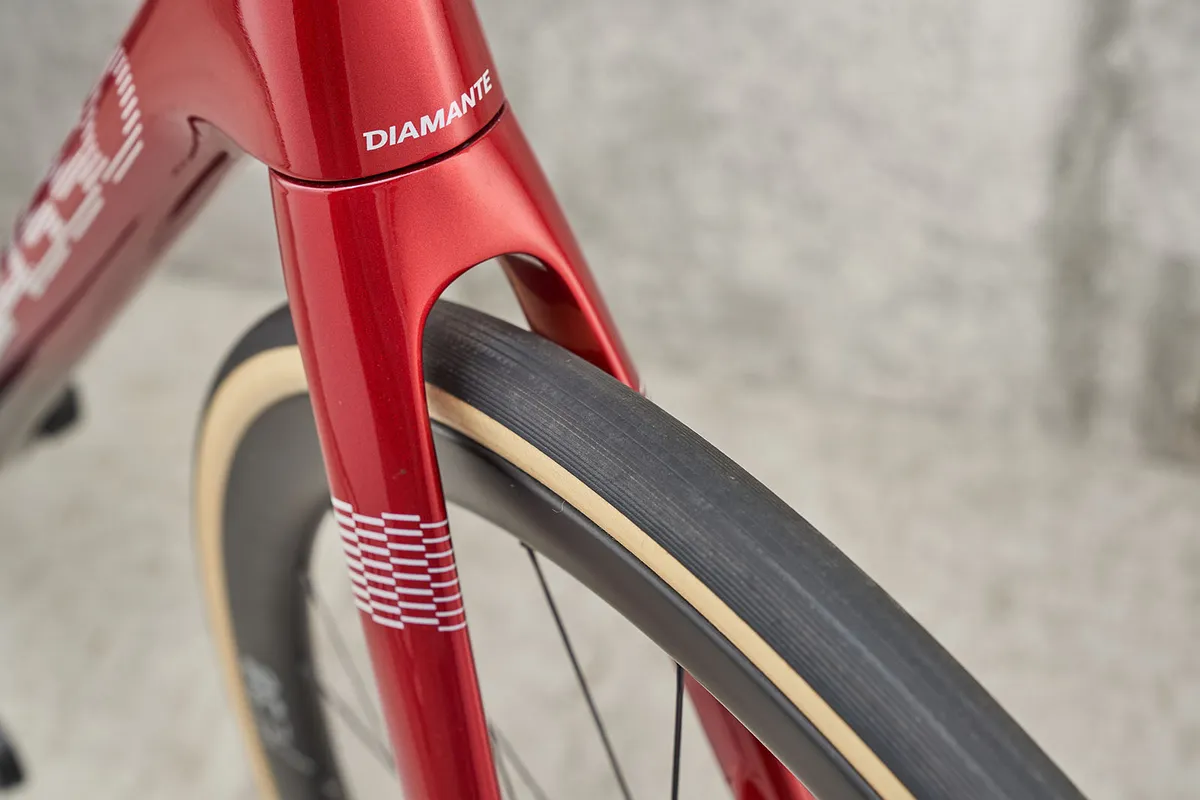
Being able to clearly feel the grip of the tyres enables you to push hard into corners and descents, and thanks to the long reach at the hoods and drops, handling is particularly stable and predictable.
Overall, climbing feels quick and satisfyingly efficient, but the low-slung front end has the effect of pushing your weight quite far forwards relative to any other bike on our 2023 Bike of the Year performance bike shortlist.
In turn, this can make getting out of the saddle quickly a little cumbersome as you stand up and get markedly forward over the bars.
I can’t criticise the powerful position this put me in over the bottom bracket (nor its speedy effects), but at the very least it takes some getting used to as you manipulate the bike side to side.
At worst, with weight generally forward, this caused some fatigue in my palms, as well as up the length of my arms and into my shoulders.
Unlike a professional rider or high-level amateur, I carry significant weight in my upper body relative to my lower half.
Although I got used to this long and low position, and the handling characteristics it brings (the bar shape is comfortable, too), it also made my hip angle more acute, putting extra load through my lower back.
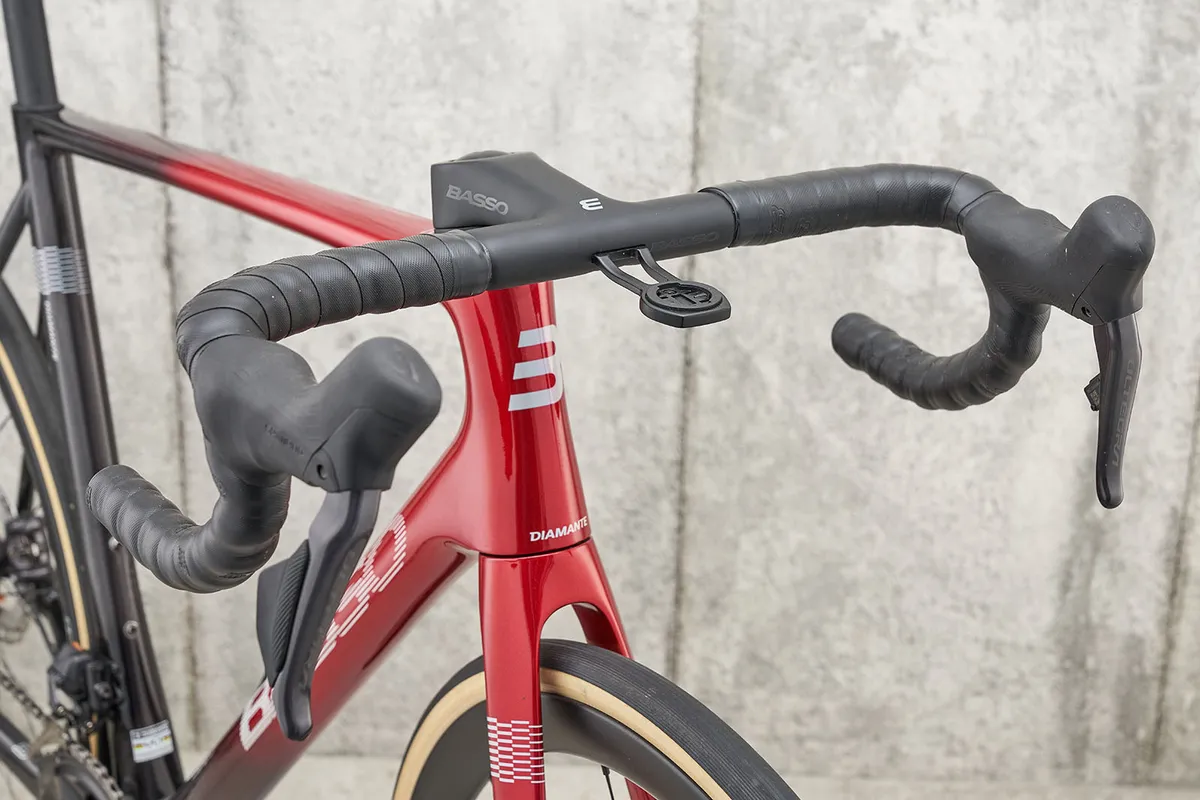
I adapted to this position by very steadily increasing test ride lengths, but it would be remiss of me to expect everyone to be able to absorb this.
In short, while it makes the ride feel involved and connected, it may pose limitations for less malleable riders who want to use the Diamante for longer rides (as quick and entertaining as it may be when you’re in the heat of battle).
Of course, you can mitigate this by adding spacers to raise the front end and opting for a shorter stem.
This will have knock-on effects other than simply easing your hip angle, though, such as saddle interaction and hand pressure.
If you’re needing to add such height to your stack, there’s an argument to say the overall frame design may not be right for you anyway.
The Diamante isn’t designed to excel on flat roads, where aero performance generally trumps all else, but the upside of the aggressive cockpit is you are in a naturally aero position.
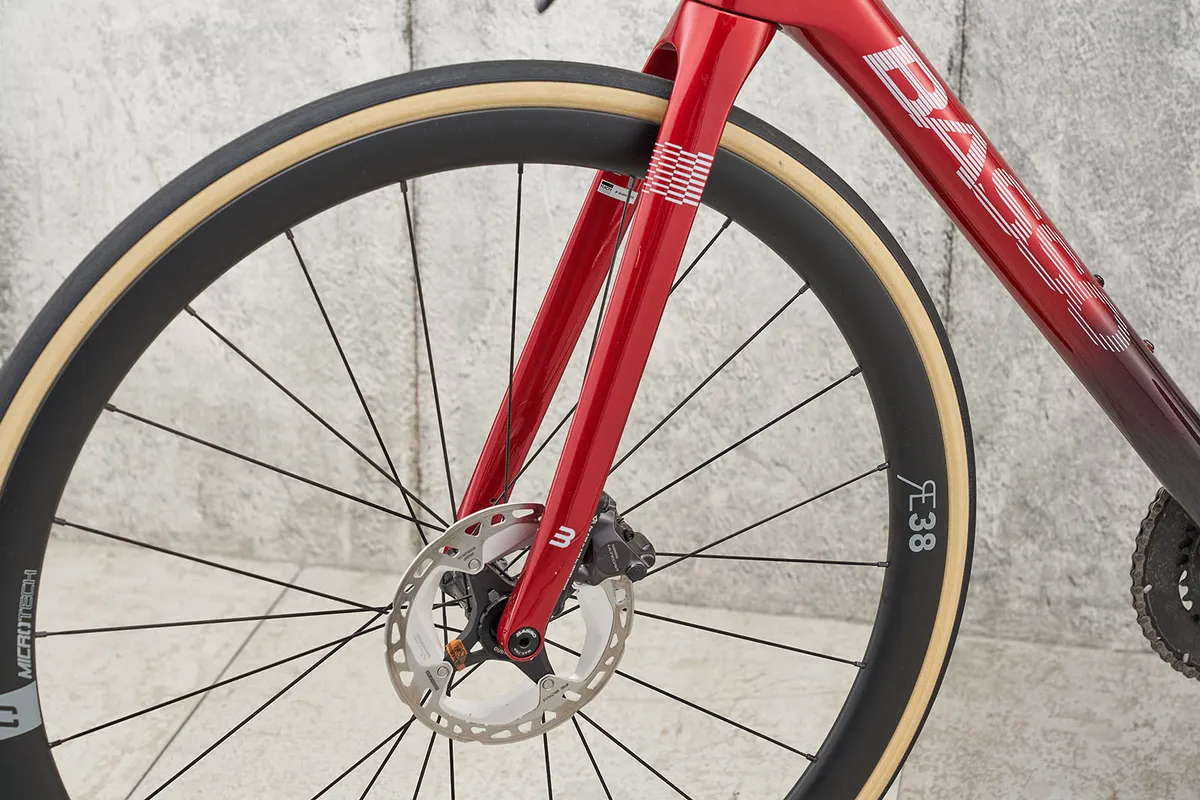
Given body position accounts for around 80-85 per cent of total system (bike plus rider) drag, I never felt hampered at the 25-35kph speeds I tend to ride at.
Any faster than that and I would probably have benefited from deeper rims. But, overall, the Microtech RE38 wheelset is a great foil for the Diamante, and I wouldn’t be rushing to upgrade to a new set of road bike wheels.
It feels responsive and the freehub responds sharply, while its (claimed) 1,560g weight is light enough to feel satisfying when climbing. The 23mm internal width naturally plays a role in maximising the volume of the nominally 28c tyres, which means you can run slightly lower pressures and get the benefit of improved grip, too.
While tubeless fans will need to swap the tyres, the clincher Corsas are impressive in their own right – the 320 TPI (threads-per-inch) cotton casing offers plenty of hallowed suppleness.
I’m slowly coming around to the idea of running tubeless setups more regularly, but this is definitely one of the better premium clincher tyres I’ve encountered.
Basso Diamante Ultegra Di2 bottom line
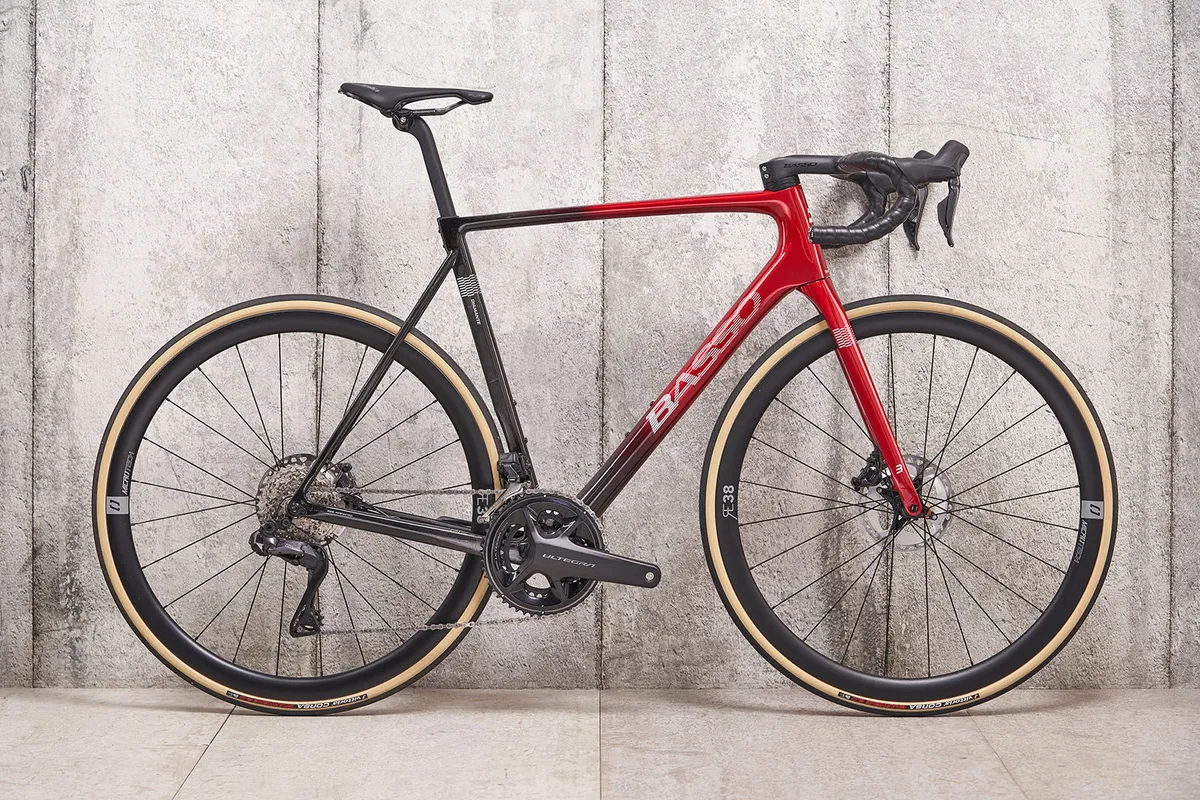
The Basso Diamante is an easy bike to like. Unless you really hanker after the look of aero profiling, it’s refreshingly pretty.
Aesthetics aside, it backs up said prettiness with a fun, involving ride. It feels quick heading up hills and coming back down the other side, and isn’t hampered as much as you might think on flat roads by its relative lack of aero details.
The overall spec is good and helps the bike to impress. Yes, there are possibilities to upgrade the wheels and tyres further, but where many brands spec bikes with disappointing rolling stock, that’s not the case here.
The Levita carbon bar-stem is comfortable, but its negative-angle stem produces a notably aggressive position. This is potentially great if you’re a pure-bred racer yourself with the flexibility, strength and weight distribution to suit it, but for everyday riders (and many amateur racers), it could be too much to bear.
In testing, it bordered on dominating my experience of the Diamante. For better or worse, the resulting position will likely dictate whether the Diamante should factor in your personal bike shortlist.
Performance Bike of the Year 2023 | How we tested
Each bike is set up as close as possible to the tester’s bike fit specifications, followed by a short, local shakedown to verify initial fit.
After this, longer separate rides are undertaken, punctuated by occasional side-of-the-road fettling (if necessary) to optimise the fit and desired ride behaviour.
Once set, a series of standalone and back-to-back rides are undertaken with each bike gradually dropping out of the running until the winner is left.
The bikes are measured in line with BikeRadar and Cycling Plus’ scoring criteria, considering overall performance in a variety of suitable situations, as well as comfort, handling, fit, specification and value for money.
Our Performance Bike of the Year contenders are
- Cannondale Supersix Evo Hi-Mod 2
- Wilier 0 SL Rival AXS
- Colnago V4Rs
- Basso Diamante Ultegra Di2
- ENVE Melee (Ultegra Di2 build)
Thanks to…
Thanks to our sponsors, Lazer, FACOM tools and Band Of Climbers for their support in making Bike of the Year happen.
Product
| Brand | basso |
| Price | 8299.00 EUR,7199.00 GBP |
| Weight | 7.5800, KILOGRAM (58cm) - without pedals |
Features
| Fork | Basso Diamante carbon, Toray 40T and 30T |
| br_stem | Basso Levita integrated, carbon |
| br_chain | Shimano Ultegra 12spd |
| br_frame | Basso Diamante carbon, Toray 40T and 30T |
| Tyres | Vittoria Corsa Graphene 2.0 clincher, 700 x 28c |
| br_brakes | Shimano Ultegra R8170 hydraulic disc |
| br_cranks | Shimano Ultegra R8170 52/36t 12×2 |
| br_saddle | Selle Italia Flite Boost Carbon SF |
| br_wheels | Microtech RE38 carbon |
| br_shifter | Shimano Ultegra Di2 R8170 |
| br_cassette | Shimano Ultegra R8170 12×2, 11-30t |
| br_seatpost | Basso integrated, carbon |
| br_handlebar | Basso Levita integrated, carbon |
| br_availableSizes | 45, 48, 51, 53, 56, 58, 61cm |
| br_rearDerailleur | Shimano Ultegra Di2 R8170 12×2 |
